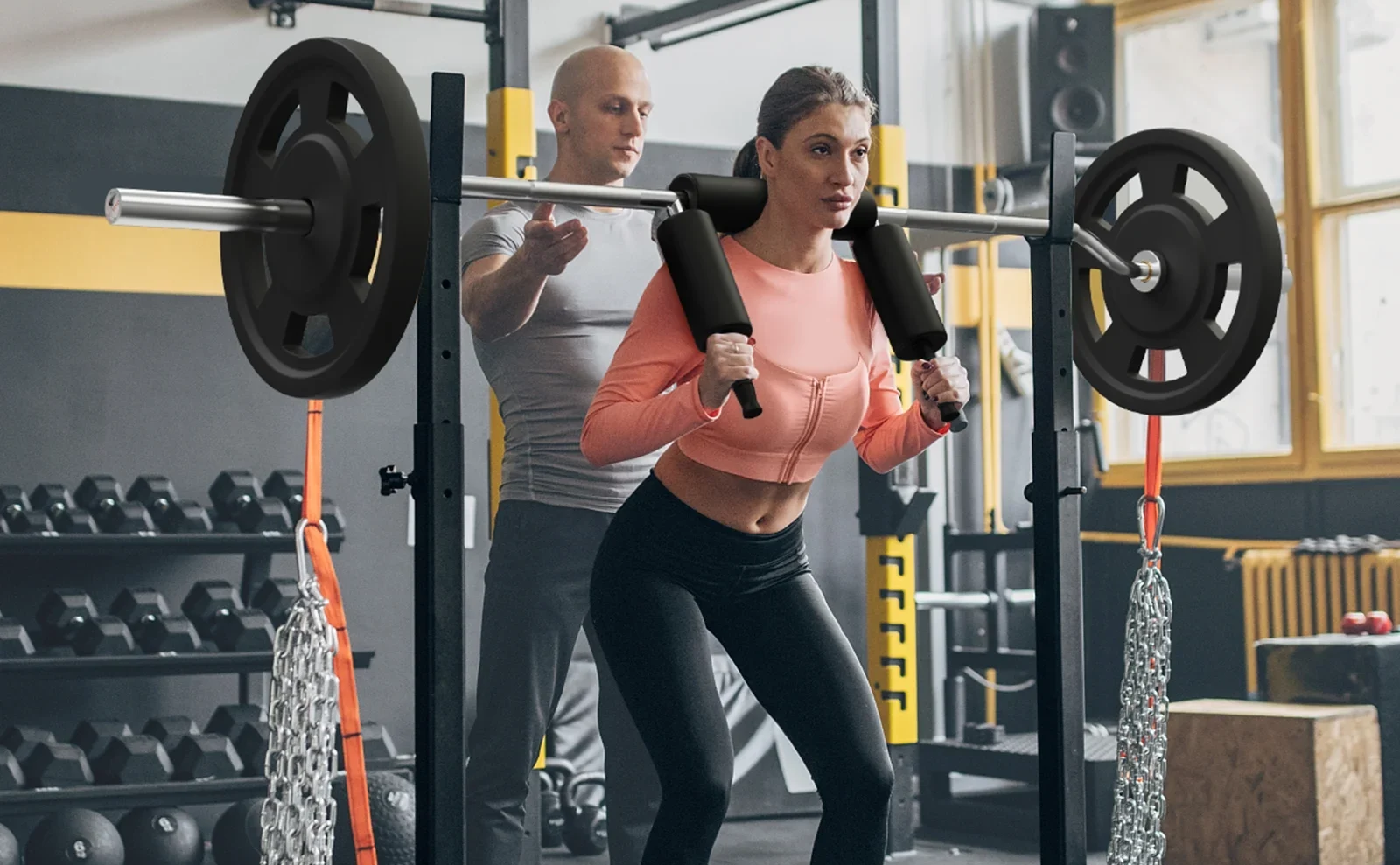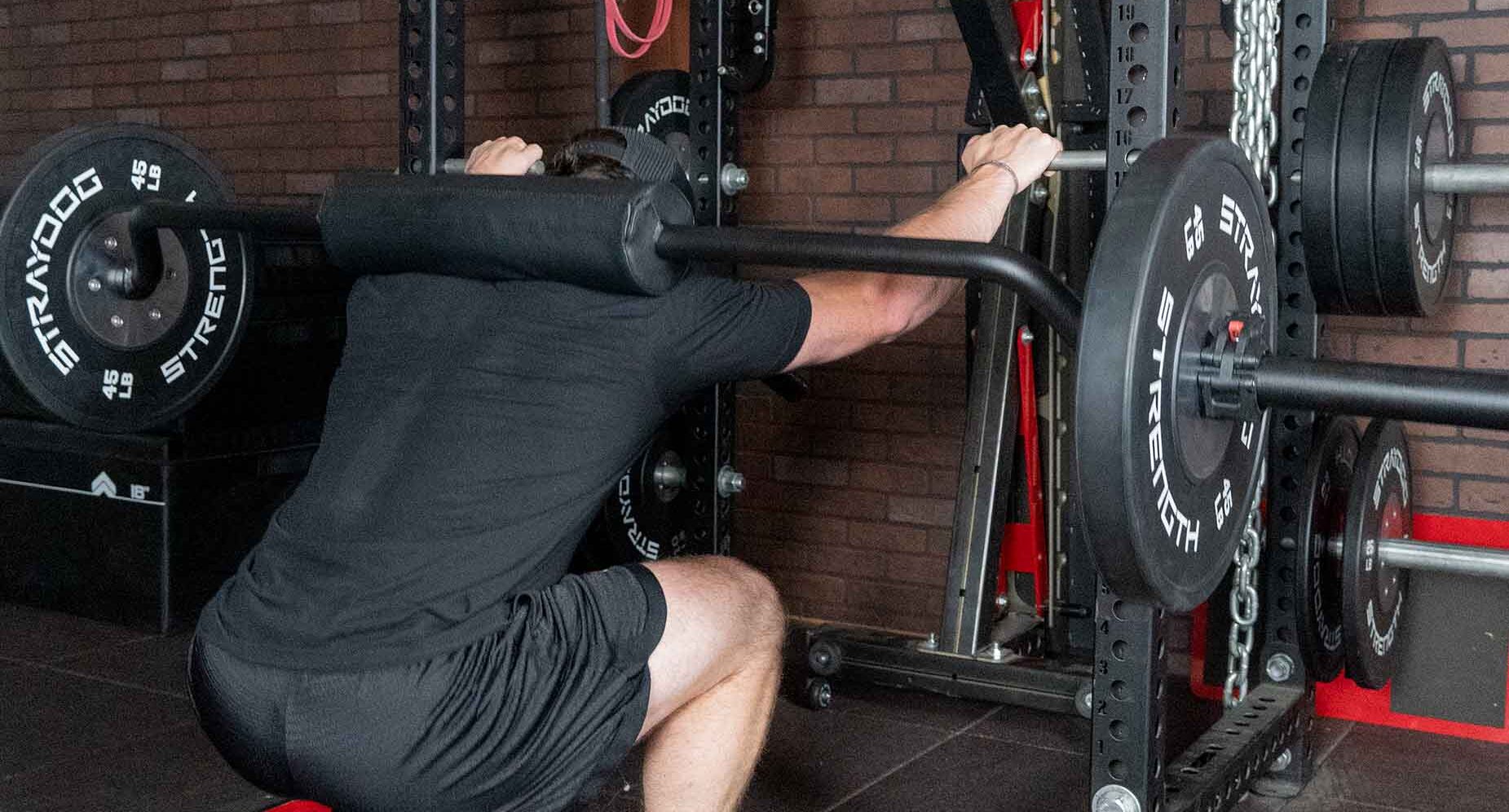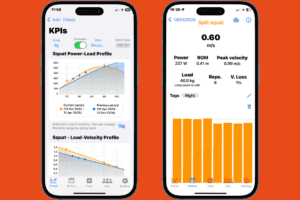O treinamento de força é um pilar fundamental da aptidão física, e os agachamentos são amplamente considerados o rei dos exercícios para a parte inferior do corpo. Mas para muitos atletas, o agachamento tradicional com barra apresenta desafios, desde desconforto até lesões. Entre no barra de agachamento de segurança (SSB), a versatile and ergonomic alternative that’s transforming how people approach squats. Whether you’re an advanced lifter or a beginner just starting your fitness journey, the safety squat bar offers unique advantages that traditional barbells simply can’t match.
In this blog, we’ll explore the benefits of the safety squat bar, compare it to other squat variations, and explain why incorporating it into your workouts can lead to better performance, improved safety, and stronger muscles.
BAIXE O APLICATIVO SPLEEFT AGORA PARA iOS, ANDROID E APPLE WATCH!
O que é uma barra de agachamento de segurança?
O barra de agachamento de segurança (SSB) is not your standard barbell. It features a padded yoke and two handles extending from the front of the bar. The bar’s sleeves are cambered, meaning they angle downward. This design shifts the center of gravity forward during lifts, changing how the body engages muscles and distributes load.
O SSB é frequentemente referido como o Barra de Hatfield, named after Dr. Fred Hatfield, a powerlifting legend known for popularizing the tool. Its unique design benefits a wide range of lifters, whether you’re recovering from an injury, building strength, or perfecting your squat technique.
Principais características que diferenciam a barra de agachamento de segurança
- Design curvo para melhor distribuição de peso
The SSB’s cambered sleeves distribute weight more evenly across your shoulders, reducing strain on your lower back and creating a more upright torso position. - Jugo acolchoado
The bar’s padded section rests comfortably on your traps, reducing pressure and preventing bruising—a common complaint with traditional barbells. - Alças Frontais
As alças voltadas para a frente eliminam a necessidade de extrema flexibilidade dos ombros, tornando a barra acessível para pessoas com dores nos ombros ou limitações de mobilidade. - Versatilidade
Além do agachamento, a barra de segurança para agachamento pode ser usada para bom dia, agachamento búlgaro, estocadas, step-ups, e muito mais.
Benefícios da Barra de Agachamento de Segurança

1. Redução da tensão nos ombros e pulsos
Ao contrário do agachamento tradicional com barra, onde você deve girar os ombros externamente para manter a barra no lugar, o agachamento com barra de segurança permite que você segure as alças frontais em uma posição neutra. Isso torna o SSB ideal para levantadores com lesões no ombro ou no pulso, ou aqueles que não têm mobilidade nessas articulações.
2. Uma opção mais segura para a coluna
O design do SSB estimula um tronco ereto, o que reduz as forças de cisalhamento na parte inferior das costas. Estudos mostraram que o agachamento com barra de segurança pode diminuir a carga da coluna lombar em comparação com agachamentos com barra convencionais. Isso torna a barra especialmente benéfica para indivíduos propensos a lesões na parte inferior das costas ou aqueles que estão se recuperando de problemas na coluna. (1)
3. Maior ativação do núcleo
Com o centro de gravidade deslocado para a frente, a barra de agachamento de segurança desafia os músculos do seu core a trabalhar mais para estabilizar seu tronco. Esse engajamento aumentado pode levar a uma melhor força funcional e equilíbrio aprimorado.
4. Acessibilidade para iniciantes e levantadores avançados
O agachamento com barra de segurança simplifica a mecânica do agachamento, facilitando o aprendizado da forma correta para iniciantes. Levantadores avançados, por outro lado, podem usar o SSB para sobrecarregar seus músculos com pesos pesados ou para adicionar variedade à sua rotina.
Barra de segurança para agachamento vs. barra: qual é melhor?
| Recurso | Barra de Agachamento de Segurança | Barra |
|---|---|---|
| Conforto no ombro | Alças neutras reduzem a tensão | Requer rotação externa do ombro |
| Carga espinhal | Reduzido devido à postura ereta | Maior devido à inclinação para frente |
| Ativação do núcleo | Maior devido à distribuição de peso para a frente | Moderado |
| Curva de aprendizagem | Mais fácil para iniciantes | Maior habilidade necessária |
| Versatilidade | Excelente para múltiplos movimentos | Usado principalmente para agachamentos e prensas |
| Ativação Muscular | Trabalha os quadríceps e a parte superior das costas | Ativação equilibrada na cadeia posterior |
Agachamento com barra de segurança vs. Agachamento com barra traseira
Enquanto o agachamento costas é um elemento básico no treinamento de força, o agachamento com barra de segurança oferece vantagens distintas. A distribuição de peso para a frente significa que seu quadríceps e core assumir mais carga de trabalho, enquanto seu parte inferior das costas experimenta menos tensão. Isso torna o SSB uma excelente alternativa para atletas lidando com dores nas costas ou aqueles que buscam enfatizar seus quadríceps.
Além disso, o SSB fornece uma pegada mais segura. Isso é particularmente benéfico durante séries de altas repetições ou levantamentos pesados, onde manter a estabilidade da barra pode ser desafiador. (3)
Quem deve usar a barra de agachamento de segurança?
1. Atletas se recuperando de lesões
O SSB é ideal para atletas em reabilitação de lesões no ombro, pulso ou costas. Seu design ergonômico minimiza a tensão em áreas vulneráveis, ao mesmo tempo em que proporciona um treino desafiador.
2. Iniciantes aprendendo o movimento de agachamento
Os novos levantadores geralmente lutam com a mecânica complexa dos agachamentos com barra. barra de agachamento de segurança simplifica esse processo ao incentivar uma melhor postura e reduzir o risco de má postura.
3. Levantadores de peso e atletas de força
For experienced lifters, the SSB can help address weaknesses. For example, the bar’s unique weight distribution increases upper back engagement, which is crucial for improving lockout strength during deadlifts.
Principais benefícios do agachamento com barra de segurança para atletas
- Melhoria da força do quadríceps
O SSB dá mais ênfase aos quadríceps, o que o torna uma ferramenta eficaz para desenvolver força explosiva na parte inferior do corpo. - Estabilidade aumentada
As alças voltadas para a frente e o garfo seguro reduzem o movimento da barra durante os agachamentos, melhorando a estabilidade e a segurança. - Equilíbrio muscular aprimorado
O SSB ativa o eretor da espinha, trapézio e dorsais, ajudando os atletas a construir uma cadeia posterior mais forte. - Versatilidade para Variações
De barra de segurança bom dia para Agachamento Hatfield, o SSB abre um mundo de possibilidades de exercícios, garantindo que nenhum grupo muscular seja negligenciado.
Como incorporar a barra de agachamento de segurança em seu treinamento
- Substituto para Agachamento com Barra
Substitua seus agachamentos regulares com barra por agachamento com barra de segurança durante semanas de descanso ou durante a recuperação de lesões. - Use para variações
Adicione variedade com exercícios como agachamento frontal com barra de segurança, Agachamento búlgaro, e barra de segurança bom dia. - Foco nos pontos fracos
Se seus quadríceps ou parte superior das costas estiverem atrasados, use o agachamento com barra de segurança para atingir essas áreas de forma mais eficaz.
Otimize seu treinamento de agachamento de segurança com Spleft
Uma das vantagens mais significativas de usar um barra de agachamento de segurança é como ele permite que os levantadores refinem sua forma e mirem grupos musculares específicos com menos risco de lesão. Mas para realmente maximizar seus ganhos, incorporar rastreamento de velocidade em tempo real e análise de desempenho pode fazer toda a diferença.
Com Perda de peso, você pode medir seu velocidade, track your power output, and monitor trends over time—all with just your smartphone or Apple Watch. For example, using Spleeft during your agachamento com barra de segurança sessions can help you identify the optimal velocity for each load, ensuring you’re staying within your target range for strength or hypertrophy goals.
Additionally, Spleeft’s treinamento baseado em velocidade (VBT) os recursos permitem que você:
- Analise seu formulário: Ao monitorar a velocidade da barra durante os levantamentos, você pode garantir um esforço consistente e ajustar sua técnica conforme necessário.
- Evite a fadiga: Use dados em tempo real para detectar quedas na velocidade que podem indicar o início da fadiga, ajudando você a evitar o overtraining.
- Definir sobrecargas progressivas: The app’s analytics can guide you in increasing your load at the right pace, ensuring steady and safe progress.
Imagine combinar os benefícios ergonômicos do barra de agachamento de segurança with Spleeft’s precise feedback. This combination can not only improve your forma de agachamento mas também fornecer insights detalhados sobre como seu desempenho evolui a cada sessão.
Considerações finais sobre a barra de agachamento de segurança
O barra de agachamento de segurança is more than just a piece of equipment—it’s a game-changer for anyone serious about strength training. Its ergonomic design, versatility, and safety features make it an indispensable tool for athletes, lifters, and fitness enthusiasts of all levels.
Whether you’re looking to rehab an injury, refine your squat technique, or simply switch up your routine, the SSB delivers unmatched benefits. In the next section, we’ll dive deeper into specific training protocols, advanced techniques, and how the safety squat bar compares to other squat tools like the barra hexagonal e barra de armadilha. (2)
O guia completo para barras de agachamento de segurança: benefícios, usos e por que você precisa de uma (parte dois)
Nesta segunda parte do nosso barra de agachamento de segurança (SSB) guide, we’ll explore advanced training techniques, variations, and how the SSB compares to other tools like the barra de armadilha e barra hexagonal. We’ll also dive into how to incorporate this versatile piece of equipment into your strength training routine effectively. Whether you’re a powerlifter, athlete, or fitness enthusiast, the SSB has something unique to offer.
Técnicas avançadas de treinamento com a barra de agachamento de segurança
O barra de agachamento de segurança isn’t just for beginners or rehabilitation; it’s an excellent tool for advanced lifters seeking to address weak points or introduce variability into their routines. Here’s how to maximize its potential:
1. Treinamento de sobrecarga
O SSB permite que os levantadores manipulem pesos mais pesados com menos esforço na parte inferior das costas e ombros. Isso o torna ideal para séries de sobrecarga, ajudando você a construir confiança com cargas mais pesadas. (2)
2. Agachamentos de tempo
By slowing down the eccentric (lowering) phase of a squat, you can increase time under tension and focus on form. The SSB’s forward weight distribution challenges your quads and core even more during tempo squats.
3. Agachamentos com pausa
Fazer uma pausa na parte inferior de um agachamento com barra de segurança é uma ótima maneira de desenvolver potência explosiva e fortalecer a transição das fases excêntrica para concêntrica do levantamento.
4. Agachamento búlgaro com SSB
For unilateral strength development, the SSB is a fantastic alternative to dumbbells or a barbell. The bar’s handles provide additional stability, making it easier to maintain balance during Bulgarian split squats.
Como a barra de agachamento de segurança se compara a outros equipamentos
Barra de Agachamento de Segurança vs. Barra de Trap
Ambos os barra de agachamento de segurança e o barra de armadilha são conhecidos por seus designs ergonômicos, mas eles têm como alvo grupos musculares ligeiramente diferentes e oferecem benefícios distintos:
| Recurso | Barra de Agachamento de Segurança | Barra de armadilha |
|---|---|---|
| Foco primário | Quadríceps, core e parte superior das costas | Glúteos, isquiotibiais e trapézios |
| Curva de aprendizagem | Moderado; mais fácil para iniciantes | Muito fácil; amigável para iniciantes |
| Postura | Promove tronco ereto | Coluna neutra com inclinação ligeiramente para a frente |
| Versatilidade | Ótimo para agachamentos e variações | Usado principalmente para levantamento terra e encolhimento de ombros |
Barra de agachamento de segurança vs. barra hexagonal
O barra hexagonal é outra ferramenta versátil frequentemente comparada ao SSB. Embora ambos reduzam a tensão na parte inferior das costas, suas aplicações diferem:
| Recurso | Barra de Agachamento de Segurança | Barra Hexagonal |
|---|---|---|
| Foco primário | Agachamentos e dominância de quadríceps | Levantamento terra e ênfase na cadeia posterior |
| Pegada | Alças frontais para fácil manuseio | Alças neutras para puxar |
| Adequação | Ideal para quem tem problemas nos ombros | Ótimo para atletas focados em levantamento terra |
Variações de Barra de Agachamento de Segurança para Desenvolvimento Completo

1. Barra de Segurança Good Mornings
Este exercício tem como alvo o eretor da espinha, glúteos e isquiotibiais, ao mesmo tempo em que coloca menos estresse na parte inferior das costas em comparação com uma barra tradicional.
2. Agachamento frontal com barra de segurança
Embora não seja convencional, realizar agachamentos frontais com o SSB pode mudar o jogo para o desenvolvimento do quadríceps e a estabilidade do core. (3)
3. Agachamento Hatfield
Named after the SSB’s pioneer, Hatfield squats allow you to hold onto the squat rack for support while using heavy loads. This variation is excellent for overloading the legs without taxing your balance.
4. Step-Ups com a barra de segurança
O SSB torna os step-ups com peso mais confortáveis e eficazes, mantendo a carga equilibrada entre os ombros.
5. Levantamento terra romeno com uma perna com o SSB
Essa variação desafia seu equilíbrio e trabalha os isquiotibiais, ao mesmo tempo em que minimiza a tensão na parte inferior das costas.
Por que a barra de agachamento de segurança é essencial na sua academia
Whether you’re an elite athlete or just beginning your fitness journey, the barra de agachamento de segurança oferece benefícios inigualáveis:
1. Prevenção de Lesões e Reabilitação
O SSB é uma ferramenta essencial para atletas se recuperando de lesões no ombro, costas ou pulso. Seu design ergonômico minimiza a tensão, permitindo que você permaneça consistente com seu treinamento.
2. Versatilidade
De agachamentos a bons dias, o barra de agachamento de segurança permite uma ampla gama de movimentos, tornando-o um dos equipamentos mais versáteis que você pode ter.
3. Melhoria na transferência de força
The SSB’s focus on core and upper back stability translates to improved performance in other lifts, such as the deadlift and bench press.
4. Conforto e Acessibilidade
O jugo acolchoado e as alças voltadas para a frente tornam o agachamento com barra de segurança mais confortável e acessível para todos os levantadores, independentemente da mobilidade ou nível de experiência.
Dicas e práticas recomendadas para a barra de agachamento de segurança
- Foco na forma: Embora o SSB reduza a curva de aprendizado, a forma correta ainda é essencial para prevenir lesões e maximizar os benefícios.
- Luz de início: If you’re new to the SSB, begin with lighter weights to get accustomed to the forward weight distribution.
- Combine com outras ferramentas: Don’t ditch traditional barbells altogether. Use the barra de agachamento de segurança como um suplemento à sua rotina existente para variedade e equilíbrio.
- Armazene-o corretamente: O design exclusivo do SSB requer armazenamento especializado. Invista em um armazenamento de barra de agachamento de segurança suporte para proteger seu equipamento e manter sua academia organizada.
Conclusão: A barra de agachamento de segurança é uma virada de jogo
O barra de agachamento de segurança isn’t just another piece of gym equipment; it’s a tool that can revolutionize your training. From reducing strain on your shoulders and spine to enhancing core activation and improving strength carryover, the SSB offers unmatched benefits for athletes of all levels.
Whether you’re using it for agachamento com barra de segurança, bom dia, ou passos, o SSB é versátil o suficiente para se encaixar em qualquer programa de treinamento. Sua capacidade de melhorar a técnica, prevenir lesões e atingir grupos musculares específicos o torna essencial para qualquer pessoa que leve a sério o treinamento de força.
If you’re looking to add variety to your routine, refine your form, or train smarter, the barra de agachamento de segurança is the answer. Don’t wait—make it a staple in your gym today and experience the difference for yourself.
Quer saber mais sobre como otimizar seu treinamento com ferramentas como a barra de agachamento de segurança? Fique ligado para mais conselhos de especialistas sobre treinamento de força, treinamento baseado em velocidade e desempenho esportivo!
Referências:
- Escamilla, RF, et al. (2001). “A Biomechanical Analysis of the Squat Exercise.”Medicine & Science in Sports & Exercise, 33(2), 358-368. Esta pesquisa analisa a cinemática e a cinética do agachamento, o que nos permitiu entender como a posição da barra e a técnica de execução (incluindo modificações como as introduzidas pela barra de agachamento de segurança) influenciam na distribuição de cargas, especialmente na coluna lombar.
- Schoenfeld, B. J. (2010). “Squatting Kinematics and Kinetics and Their Application to Exercise Performance.”Revista de Pesquisa em Força e Condicionamento, 24(12), 3497-3506. Embora se concentre no agachamento em geral, este estudo oferece uma descrição detalhada dos movimentos e forças envolvidas na execução do agachamento, informações úteis para entender como mudanças na configuração (por exemplo, o uso de uma pegada neutra ou a modificação do centro de gravidade) podem diminuir a carga em certas estruturas, como a região lombar, e melhorar a ativação do core.
- Swinton, P. A., et al. (2012). “A Biomechanical Analysis of the Safety Squat Bar Squat Compared with the Back Squat.” Journal of Strength and Conditioning Research, 26(7), 1908-1916. Este estudo comparou diretamente os aspectos biomecânicos do agachamento com barra de segurança e do agachamento convencional. Os resultados mostraram diferenças na postura do tronco e nos padrões de ativação muscular, o que reforça as vantagens do SSB em termos de redução da tensão lombar e maior envolvimento do core.
Iván de Lucas Rogero
Desempenho Físico MSC e CEO SpeeftApp
Dedicado a melhorar o desempenho atlético e o treinamento de ciclismo, combinando ciência e tecnologia para gerar resultados.





